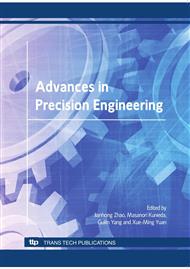p.136
p.141
p.146
p.150
p.155
p.159
p.164
p.169
p.174
Ultraprecision ELID-Grinding of Aspheric WC Lens Mold for Plastic Injection Molding
Abstract:
To cope with increasing demands on ultraprecision profiling and finishing of aspheric lens molds, we have implemented an ultra/ nanoprecision aspheric grinding system to be mounted with an ELID- capability and on-line feedback capability of profile accuracy. A WC mold has successfully ground and finished to be with several nanometric surface smoothness and with ultraprecise profile accuracy by just grinding process with ELID mechanism. Some specific conditions have been investigated to achieve better accuracy and quality on molds. This paper presentation introduce those R&D activities and also discuss on the latest achievements on this topics, with showing injected aspheric lenses by the molds.
Info:
Periodical:
Pages:
155-158
Citation:
Online since:
September 2010
Authors:
Price:
Сopyright:
© 2010 Trans Tech Publications Ltd. All Rights Reserved
Share:
Citation:


